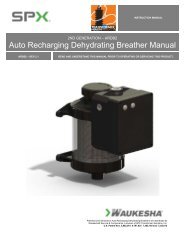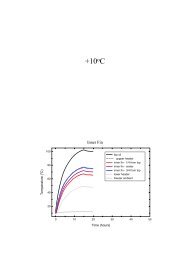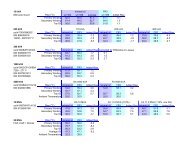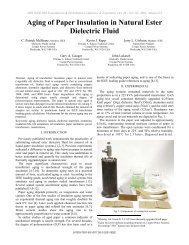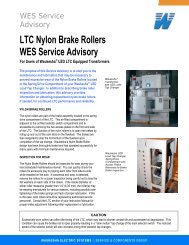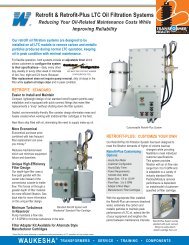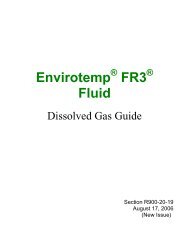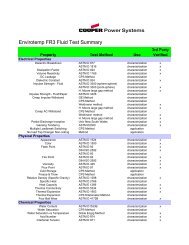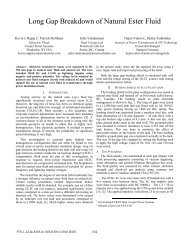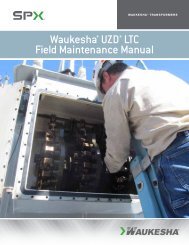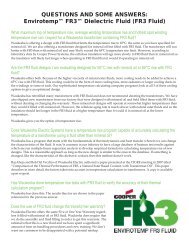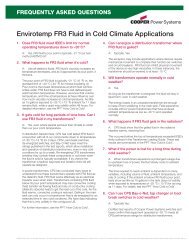WICOR Pressboard Impregnation Report - SPX Transformer Solutions
WICOR Pressboard Impregnation Report - SPX Transformer Solutions
WICOR Pressboard Impregnation Report - SPX Transformer Solutions
You also want an ePaper? Increase the reach of your titles
YUMPU automatically turns print PDFs into web optimized ePapers that Google loves.
REPORT # 3206 REV. 0<br />
DATE WRITTEN: 2/3/06<br />
SUBJECT / TITLE:<br />
KEYWORDS:<br />
Oil <strong>Impregnation</strong> Rate of Cooper FR3 Oil<br />
FR3 Vegetable Oil <strong>Impregnation</strong><br />
SUMMARY:<br />
[Purpose]<br />
To determine the time to impregnate laminated pressboard with Cooper FR3 Oil. FR3 has a higher<br />
viscosity than mineral oil. The higher viscosity affects the impregnation rate.<br />
[Procedure]<br />
Blocks of TX2, laminated pressboard, were fabricated to a dimension of 8 inch x 8 inch x 1 inch thick.<br />
Each block had a 0.5” diameter hole drilled in the center of the block. The edges of the block were coated<br />
with polyester resin to prevent oil penetration from the edge.<br />
All blocks were dried in a circulating hot air oven at 105 C for 48 hours followed by vacuum drying at 105<br />
C for 48 hours. The blocks were then placed in a hot air oven at 105 C until needed for testing.<br />
The rate of oil impregnation was tested at 60 C, 80 C, and 100 C. For each temperature, six blocks were<br />
taken from the hot air oven (set at 105 C) and placed in a vacuum oven set to the temperature at which<br />
the impregnation rate was to be determined, 60, 80 or 100 C. The blocks were left in the vacuum oven for<br />
at least 24 hours or a vacuum reading of less than 300 microns Hg was achieved. In the meantime FR3<br />
oil was heated to the corresponding test temperature.<br />
The FR3 oil was introduced into the vacuum oven until the TX2 blocks were covered with fluid. A vacuum<br />
level of less than 500 Microns Hg was maintained during this vacuum impregnation period. The blocks<br />
were then left in the FR3 fluid for various periods of time.<br />
After specific time intervals a block was removed from the fluid and split in half. The rate of oil<br />
impregnation was measured visually by the darkened pressboard. Samples were removed from the oil and<br />
the impregnation distance measured until the block was completely impregnated to the edge.<br />
[Background]<br />
Cooper FR3 fluid is an alternative to mineral oil for distribution and power transformers. Due to the higher<br />
viscosity of FR3 in comparison to mineral oil the rate of oil impregnation was postulated to be slower than<br />
mineral oil.<br />
[Observations]<br />
Observations can be seen in the attached graph on page 2.<br />
ELECTRICAL TECHNOLOGY<br />
[Conclusions]<br />
FR3 fluid takes longer to impregnate than mineral oil. In project #1866 (December, 1993) the rate of<br />
impregnation of mineral oil was determined at 20 C, 45 C, and 90 C. A good way to compare relative<br />
impregnation times is to compare the time that it takes to impregnate a distance of 3 inches. EHV<br />
Weidmann recommends that oil impregnation and dryout holes be placed in laminated pressboard on 4<br />
inch centers. If one assumes a 3 inch distance for impregnation then a plate of laminated pressboard<br />
would be completely impregnated in this time.
A summary of the time to impregnate:<br />
Fluid: FR3<br />
Temperature<br />
Time to Impregnate 3 Inches<br />
60 C 42 Hours<br />
80 C 37 Hours<br />
100 C 30 Hours<br />
From project 1866:<br />
Fluid: Mineral Oil<br />
Temperature<br />
Time to Impregnate 3 Inches<br />
20 C 120 Hours<br />
45 C 25 Hours<br />
90 C 18 Hours<br />
Oil <strong>Impregnation</strong> Rate of FR3 Fluid<br />
4.5<br />
4<br />
<strong>Impregnation</strong> Distance from 0.5" hole (Inches)<br />
3.5<br />
3<br />
2.5<br />
2<br />
1.5<br />
1<br />
60 Degrees C<br />
80 Degrees C<br />
100 Degrees C<br />
0.5<br />
0<br />
0 10 20 30 40 50 60 70 80<br />
<strong>Impregnation</strong> Time (Hours)<br />
EHV-Weidmann Type of <strong>Report</strong>: Lab Test <strong>Report</strong><br />
Language: English Author: Tom Prevost Originator: Tom Prevost<br />
Cost: Test Completed: February 6, 2006<br />
Related <strong>Report</strong>s: 1866<br />
Laboratory Manager:




